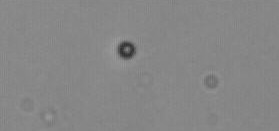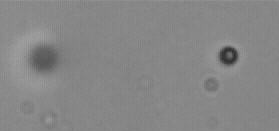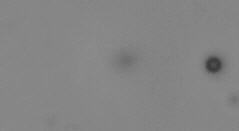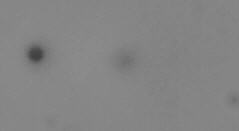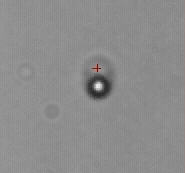Trapping by light: laser tweezers
Laser tweezers were developed from the experiments of A. Ashkin in 1970's, who studied action of light pressure on microscopically small objects in air or water. Laser tweezers are based on strongly focused laser light, which exerts forces on transparent dielectric objects, provided their index of refraction is larger compared to that of the surroundings. In this way, small transparent objects are trapped into the laser focus and can be manipulated in space by moving the laser spot.
In liquid crystals, which are birefringent complex fluids, small, micrometer sized transparent particles can be trapped and manipulated, although their index of refraction is lower than both refractive indices of the surrounding liquid crystal. This is contrary to intuition, but can be understood considering polarization and topological properties of liquid crystals around inclusions.

The time-series of microscopic images under crossed polarizers, showing attraction of 1 micrometer silica particle to the trap of the laser tweezers (60 mW) in homeotropic cell filled with 5CB nematic liquid crystal. The trap is visible because the laser induces optical Freedericksz transition above 30 mW and the distorted region is birefringent. The time difference between individual images is 2.5 seconds.
Laser trapping in liquid crystals is effected by three accompanying phenomena connected with propagation of a strong light inside the nematic liquid crystal (NLC):
i) Below the optical Fréedericksz transition, the trapping is due to the anisotropic dielectric interaction of the polarized light with the inhomogeneous director field around the colloid.
ii) Freedericksz transition: when electric field is applied perpendicular to a planar layer of NLC, the dielectric torque rotates the molecules into the field transition, which is usually observed at a certain threshold. The same effect can be observed in strong light, but is induced by the E-field of the electromagnetic wave. The optical trapping is accompanied by the elasticity-mediated interaction between the optically distorted region of a liquid crystal and the colloid. The trapping above the Fréedericksz transition is highly anisotropic.
iii) At very high power (several 100's mW, focused), NLC could be locally molten due to absorption of light. This creates small isotropic drops in the laser tweezers focus, which interact with particles in the NLC due to surface tension between isotropic and nematic phase.
|
|
1.I. MUŠEVIČ, M. ŠKARABOT, D. BABIČ, N. OSTERMAN, I. POBERAJ V. NAZARENKO, V. A. NYCH, Laser trapping of small colloidal particles in a menatic liquid crystal : clouds and ghosts. Phys. rev. lett., 2004, vol. 93, p. 187801-1-187801-4.2.B. LEV, A. NYCH, U. OGNYSTA, S. CHERNYSHUK, V. NAZARENKO, M. ŠKARABOT, I. POBERAJ, D. BABIČ, N. OSTERMAN, I. MUŠEVIČ, Anisotropic laser trapping in nematic colloidal dispersion. The European physical journal. E, Soft matter, 2006, vol. 20, str. 215-21923.3.M. ŠKARABOT, M. RAVNIK, D. BABIČ, N. OSTERMAN, I. POBERAJ, S. ŽUMER, I. MUŠEVIČ, A. NYCH, U. OGNYSTA, V. NAZARENKO, Laser trapping of low refractive index colloids in a nematic liquid crystal. Phys. rev., E Stat. nonlinear soft matter phys. (Print), 2006, 73, str. 021705-1-021705-10. |


